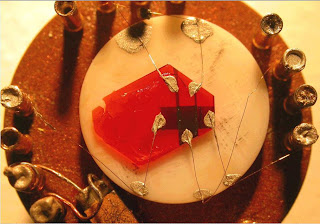Finding reported in Nature Materials journal could boost role of solar-generated electricity as alternative to fossil fuels
NEW BRUNSWICK, N.J. – Physicists at Rutgers University have discovered new properties in a material that could result in efficient and inexpensive plastic solar cells for pollution-free electricity production.
The discovery, posted online and slated for publication in an upcoming issue of the journal Nature Materials, reveals that energy-carrying particles generated by packets of light can travel on the order of a thousand times farther in organic (carbon-based) semiconductors than scientists previously observed. This boosts scientists' hopes that solar cells based on this budding technology may one day overtake silicon solar cells in cost and performance, thereby increasing the practicality of solar-generated electricity as an alternate energy source to fossil fuels.
"Organic semiconductors are promising for solar cells and other uses, such as video displays, because they can be fabricated in large plastic sheets," said Vitaly Podzorov, assistant professor of Physics at Rutgers. "But their limited photo-voltaic conversion efficiency has held them back. We expect our discovery to stimulate further development and progress."
Excitons are particle-like entities consisting of an electron and an electron hole (a positive charge attributed to the absence of an electron). They can generate a photo-voltage when they hit a semiconductor boundary or junction, and the electrons move to one side and the holes move to the other side of the junction. If excitons diffuse only tens of nanometers, only those closest to the junctions or boundaries generate photo-voltage. This accounts for the low electrical conversion efficiencies in today's organic solar cells.
"Now we lose 99 percent of the sunlight," Podzorov noted.
While the extremely pure rubrene crystals fabricated by the Rutgers physicists are suitable only for laboratory research at this time, the research shows that the exciton diffusion bottleneck is not an intrinsic limitation of organic semiconductors. Continuing development could result in more efficient and manufacturable materials.
The scientists discovered that excitons in their rubrene crystals behaved more like the excitons observed in inorganic crystals – a delocalized form known as Wannier-Mott, or WM, excitons. Scientists previously believed that only the more localized form of excitons, called Frenkel excitons, were present in organic semiconductors. WM excitons move more rapidly through crystal lattices, resulting in better opto-electronic properties.
Podzorov noted that the research also produced a new methodology of measuring excitons based on optical spectroscopy. Since excitons are not charged, they are hard to measure using conventional methods. The researchers developed a technique called polarization resolved photocurrent spectroscopy, which dissociates excitons at the crystal's surface and reveals a large photocurrent. The technique should be applicable to other materials, Podzorov claims. ###
Collaborating with Podzorov on the research were postdoctoral researcher Hikmat Najafov, graduate students Bumsu Lee and Qibin Zhou, and Leonard Feldman, director of the Rutgers Institute for Advanced Materials, Devices and Nanotechnology (IAMDN). Najafov and Podzorov are also affiliated with IAMDN.
Funding was provided by the National Science Foundation's Division of Materials Research and Japan's New Energy and Industrial Technology Development Organization (NEDO).
Contact: Carl Blesch cblesch@ur.rutgers.edu 732-932-7084 x616 Rutgers University
EDITOR'S NOTE: Professor Podzorov may be contacted at 848-391-5371 or podzorov@physics.rutgers.edu.















No comments:
Post a Comment